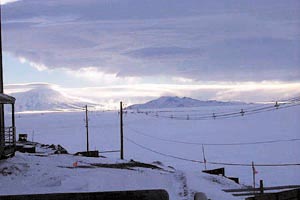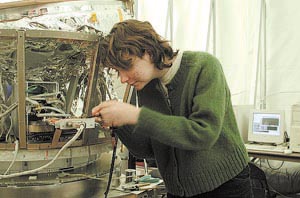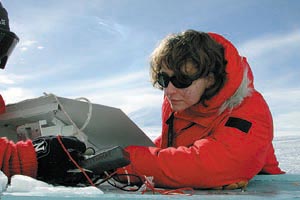Physics concentrator studying universe from Antarctica
Gwynne Crowder, a physics concentrator, is in Antarctica until mid-January working on a project called TopHat with Stephan Meyer, Professor in Astronomy & Astrophysics. The Center for Astrophysical Research in Antarctica http://astro.uchicago.edu/cara is underwriting Crowder's work in Antarctica under the auspices of its education and outreach programs. Crowder is chronicling her journey for elementary school students at http://topweb.gsfc.nasa.gov/antarctica/chronicles.html. She e-mailed the Chronicle information about her life there.
 |
Antarctica is the coldest, windiest and driest continent on Earth. The coldest recorded temperature is minus 128 F. Human skin flash freezes at only minus 80 F. It’s incredibly beautiful and barren. When it’s cloudy, it’s impossible to see anything because everything is white. Having daylight all the time is a little weird.
Research:
We are measuring the cosmic microwave background radiation. We are using a helium balloon to fly our instrument above approximately 99 percent of the atmosphere, recording information from photons that are completely unchanged since the early universe. From this measurement, we can determine the total mass and energy in the universe, the age of the universe and whether it will continue expanding or start contracting. Also working on the project are the University of Wisconsin, NASA and the Danish Research Institute.
 Gwynne Crowder probes the gyroscope card and checks to make sure everything is up to par in the telescope. Crowder is working on a project called TopHat, a balloon experiment to study the cosmic microwave background radiation, which is the afterglow of the big bang. Measurements collected from the experiment will allow scientists to determine the total mass and energy in the universe, the age of the universe and whether it will expand forever or eventually contract. |
Antarctica is, by international treaty, to be kept a pristine environment. Seventy percent of all waste here is recycled. Everything is rationed. I am allowed three two-minute showers per week. I get up at 7 a.m. and drive to the remote field camp where I work until about 5:30 p.m.
 |
Most challenging aspect:
It is probably hardest not having a close friend around. I guess this is mainly a matter of adjusting to a new environment. I miss my friends and family.
Favorite memory so far:
A survival course called Happy Camper School. The instructors tell you what to do in case of emergencies, and then leave you with supplies out on the Ross Ice Shelf for one night. We build several types of shelters–Scott tents, expedition tents sheltered by a snow brick wall, trenches with snow brick ceilings and Quinzhees. I stayed in the last type. You make these by piling all your gear in a big heap. Then you shovel enough snow to cover the pile in two or three feet all over. Let this settle for a while, and then dig a tunnel underground that leads to the center part (this stops the wind from coming in). Pull out the gear and voila, you have a shelter. I have to admit to some feelings of claustrophobia, but it was well worth it. I didn’t even realize when a storm blew in and created a whiteout.
![[Chronicle]](/images/small-header.gif)